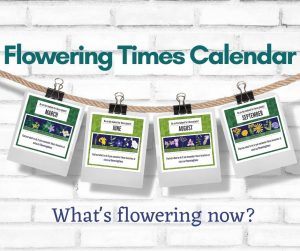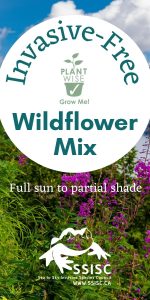
Did you know that invasive plants are often traded, grown and planted in the horticultural industry?

Did you know that invasive plants are often traded, grown and planted in the horticultural industry?
Be PlantWise
Invasive plants are often easy to grow in a variety of conditions, establish and spread easily, and are usually as beautiful as other ornamental plants. However, outside their native range they can run wild and take over the landscape, causing environmental and economic harm.
The Invasive Species Council of BC‘s PlantWise website profiles invasive plants commonly found in horticulture, and offers suggestions for non-invasive and native alternatives to grow instead.
Grow Me Instead
Luckily, being PlantWise doesn’t mean you have to bid your garden goodbye. By using the Grow Me Instead Guide, you can make informed choices about common invasives to avoid and alternative plants to replace them with in your garden.
Be Bear Smart
The Sea to Sky region is home to bears, so it’s important to choose non-invasive species that are also bear-smart. A good rule of thumb is to avoid planting anything that produces fruits, berries, or nuts, even if they are native. For instance, when choosing what to plant in your garden, the Resort Municipality of Whistler recommends avoiding fruit-bearing trees or plants, as ripe fruits are significant bear attractants.
The Grow Me Instead guide is an excellent resource for discovering non-invasive alternatives, with each page featuring “Plant Special Features” that highlight bear-smart options. As you explore the guide, keep an eye out for these bear-friendly plants!
To learn more about bear smart gardening, click the button below:

Common Invasive Plants
Unfortunately, many local and online plant retailers still sell invasive plants and/or seeds. Here’s a list of some species you should avoid purchasing / growing:
- English Ivy (Hedera helix)
- Baby’s Breath (Gypsophila paniculate)
- Yellow Flag Iris (Iris pseudacorus)
- Scentless Chamomile (Matricaria maritima)
- Common Toadflax (Linaria vulgaris)
- Dalmatian Toadflax (Linaria dalmatica)
- Leafy Spurge (Euphorbia esula)
- Spurge Laurel (Daphne laureola)
- Yellow Lamium (Lamium galeobdolon)
- Bachelor’s Buttons (Centaurea cyanus)
- Mountain Bluet (Centaurea montana)
- Common (or small) Periwinkle (Vinca minor)
- Butterfly Bush (Buddleja davidii)
- English holly (Ilex aquifolium)
- Chicory (Cichorium intybus)
- Oxeye Daisy (Chrysanthemum leucanthemum)
Please note – this isn’t an exhaustive list of all the invasive species you might see sold in local stores. You can find a longer list of species here.
Commonly-Used Gardening Terms
Some people tend to use many terms pretty loosely, especially the term ‘invasive’.
Here are some definitions of commonly-used gardening terms:
- Native Plants: Plants that were found in a particular region prior to human introduction.
- Cultivated Plants: Plants that are intentionally planted and grown by humans for use as food, medicine, decoration, etc.
- Invasive Plants: Plants that are not native to a particular area and that also cause negative impacts to the economy, the environment or human health.
- Open Pollination: When pollination occurs naturally (rather than with humans’ intentional assistance). This leads to more genetically-diverse plants.
To learn more on the topic:

PlantWise Businesses
By adopting PlantWise principles, you are committing to becoming an invasive-free establishment.
Interested in joining a network of businesses across BC that are leaders in responsible gardening? Simply get in touch with us to get started!
Thank you to these PlantWise businesses for their support:
Keep Your Eyes Open
If a plant (whether it’s sold in a pot or in a seed packet) is labelled as “self-seeding”, a “fast spreader”, or “drought tolerant”, you might want to take a closer look, as those are typical characteristics of invasive plants. Better yet, look over our plant list to confirm your suspicion!
If you spot an invasive species for sale at a nursery or plant store, or if you find one in your garden, let us know!

Yellow Flag Iris is an invasive plant that is sometimes used in the horticultural trade and even sold in garden stores. If you spot it, report it!
Are You a Pro?
Are you a landscaping or earth-moving professional in the Sea to Sky? Have you taken the Invasive-Free Certification program?
SSISC’s Invasive-Free Certification program is the first of its kind in BC. The goal of this program is to integrate targeted invasive species management into the practices of horticulture, landscaping, and earth-moving companies serving the Sea to Sky Corridor, and recognize those companies contributing to stopping the spread of invasive species.
New! The Invasive-Free Certification program is now offered online.
Resources
Caution: Toxic!
Did you know that some invasive plants found in the Sea to Sky Corridor are not only harmful to the environment, but they are also toxic to humans or animals?
Learn more about the identification and control of Toxic Invasive Plants in the Sea to Sky Corridor that directly impact human, lifestock, and pet health. Although some native plants can also be toxic, only high priority toxic invasive species in the Sea to Sky are included here.
In addition to being toxic, many of these plants have additional negative impacts that include:
- reduction of native biodiversity and habitat;
- adversely affecting forage production and quality; and
- decreased water quality and quantity.
Got Knotweed?
Defend your property from Knotweed invasion
Invasive knotweeds are native to Asia but can be found at large in British Columbia just about anywhere including driveways, gardens, roads, ditches and creeks. They grow to three meters tall, can cause extensive damage to private and public property, and wreaks havoc on the environment. These plants spread aggressively by root (20 meters horizontally!), seed and plant fragments.
Watch these short videos, or peruse the “Knot On My Property” brochure that we developed in partnership with the Invasive Species Council of Metro Vancouver (ISCMV) and Fraser Valley Invasive Species Society (FVISS), to find out what to do, or more appropriately what “knot” to do if you find knotweed on your property.
What’s New in Your Garden?
Be on the lookout for invasive plants flowering in the Sea to Sky!
The Flowering Times Calendar is a fun way to highlight some of the interesting, invasive plants that may catch your eye.
7 Red Flags
Plant characteristics that may be used to describe invasives
Our 7 Red Flags mobile download includes information about 7 common terms that may be used to describe invasive plants, as well as examples of invasive species in the Sea to Sky region with each trait.
Keeping an eye out for these terms could prevent you from bringing home an invasive plant, and helps to stop the spread of harmful garden invasives in the Sea to Sky!
Frequently Asked Questions
Shouldn't it be illegal to purchase or plant invasive plants?
That is a great question! The BC Weed Control Act & Regulation require land occupiers to ‘control noxious weeds growing or located on land and premises’, but the list is not exhaustive (see Schedule A). This legislation also provides the legal framework for notices to be served, and in some cases, treatment costs to be recovered.
Invasive species managers have been communicating the need for the new legislation (e.g., an Invasive Species Act for BC) that would ban the sale of invasives, and address all species – not just noxious weeds. In order for a new act to be drafted and enacted however, we need members of the community like you to write to their MLA calling to action to create and adopt an Invasive Species Act for BC.
In the meantime, some municipalities, including Whistler, have tried to address this gap in the provincial regulations by adopting bylaws that make it a ticketable offense to plant invasive plants on one’s property. In 2021, the District of Squamish also adopted an Invasive Species Management Bylaw, which prohibits a person from sowing, planting, cultivating, releasing or spreading an invasive species on any property within the district. Additionally, no person or business can sell or distribute invasive species within the District. The list of invasive species to which this bylaw applies, are those species listed under the Community Charter – Spheres of Concurrent Jurisdiction. You can learn more about the bylaws and regulations that apply to invasive species on this page.
I want to create a 'wild' garden. Can't I just let the invasive plants run wild?
Unfortunately not. Second only to habitat loss, invasive plants and animals have been identified as the most significant threat to biodiversity. For instance, invasive plants can alter water flow and lead to erosion or a reduction in available water, create and increase fire hazards, damage roads and other built structures, contain substances that are toxic to humans and animals, and reduce crop yields.
With invasive species, the cost of doing nothing is too high: we need to act as soon as possible, since the control and restoration costs increase exponentially over time.
Read more about native and non-invasive plant alternatives to include in your garden
How do I get informed about what I should and shouldn't be growing?
Our species profile pages is a great place to get started if you want to learn about invasive species found in the Sea to Sky.
We also invite you to peruse the Grow Me Instead brochure, which presents invasive plants commonly found in the horticultural trade, as well as non-invasive alternatives.
I've pulled up some invasive plants from my property. How do i get rid of the debris?
If you remove any invasive plants from your yard or your neighbourhood (thank you!), please remember to:
- Separate invasive plant material from yard waste
- Place invasive plant material in a bag, or on a tarp, & seal it
- Take to the transfer station/landfill
- DO NOT COMPOST!
Please refer to your community’s page for community-specific disposal advice and regulations.
I want to get involved and volunteer my time. How do I do it?
Great question!
If you would like to:
- give back to the environment
- get some fresh air
- develop a new skill
- volunteer your time
We are currently in the process of fleshing out our volunteer strategy, but we want to hear from you, and we’ll be in touch soon.
Alternatively, you can also sign-up for our newsletter to be kept informed of any upcoming opportunities and events.
How do you treat invasive plants?
We’re glad you asked!
Learn more about Invasive Plant Management
If you are looking for species-specific recommendations, have a look at our species page. You can always also contact us with any questions.
Invasive-Free Seed Mix
Did you know that wildflower seed mixes may contain invasive plants that harm the environment?
By using an invasive-free seed mix on your property, you can be assured that you are not spreading invasive plants by accident.
SSISC is now offering packets of invasive-free wildflower seed mix. The seed mix packets are available to residents of the Sea to Sky region.
Invasives in Birdseed
What’s in your birdseed mix?
Invasive plant seeds could easily be hiding in the mix. Learn more about how to avoid purchasing birdseed that contains invasive seeds here.
Links
Brochures and Handouts
- Grow Me Instead (Invasive Species Council of BC – ISCBC)
- Field Guide to Noxious and Other Selected Invasive Plants of British Columbia (ISCBC and Government of BC)
- Toxic Invasive Plants in the Sea to Sky Corridor (SSISC)
- Guide to Identification and Management of Invasive Plants in the Sea to Sky (SSISC)
- 7 Red Flags (SSISC)
















